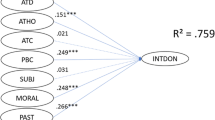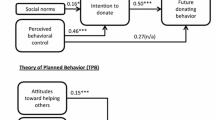Abstract
Given an increasing global need to elicit and stimulate charitable giving and in light of the limited social-psychological research on this subject, this study contributes to a better empirical understanding of the factors that underlie charitable giving (intentions). In contrast to previous research, it was hypothesized that moral norms rather than social norms are likely to play a significant role in the formation of charitable intentions. An extended Theory of Planned Behavior (TPB) model was constructed in order to test the influence of six social-psychological variables on an individual’s intention to donate to charity. Respondents (N = 143) completed an online questionnaire about charitable behaviour that assessed the constructs of the revised model. The present study found support for the stated hypothesis: while social norms (both descriptive and prescriptive) did not explain any of the variance in intention, moral norms accounted for a significant amount of the overall variance and were in fact identified as the strongest (relative) predictor of charitable giving intentions. In addition to moral norms, ‘attitude’, ‘perceived behavioral control’ and ‘past behaviour’ were also identified as significant predictors. The findings in this study support a revised TPB model that accounts for nearly 70% of the explained variance in charitable intent. Implications for both theory and practice are discussed.


Similar content being viewed by others
Notes
Of course, in some situations when it remains relatively unclear what the appropriate norm is, it is likely that people will look at others for clues (e.g., Festinger 1954).
Even if some correlations (.61) are to be considered relatively high, an examination of the collinearity statistics revealed that each predictor fell within acceptable boundaries of tolerance (>.3) and the VIF coefficient (<5), ruling out any substantive multi-collinearity problems (O’Brien 2007).
References
Ajzen, I. (1991). The theory of planned behavior. Organizational Behavior and Human Decision Processes, 50, 179–211.
Ajzen. (2002). Residual effects of past on later behavior. Habituation and reasoned action perspectives. Personality and Social Psychology Review, 6, 107–122.
Ajzen, I. (2006). Theory of planned behavior. Constructing A TPB Questionnaire. Retrieved on December 21st, 2010 from: http://www.people.umass.edu/aizen/pdf/tpb.measurement.pdf.
Albarracín, D., Johnson, B. T., & Zanna, M. P. (2005). The handbook of attitudes. Mahwah: Lawrence Erlbaum.
Armitage, C. J., & Conner, M. (2001). Efficacy of the theory of planned behavior: A meta-analytic review. British Journal of Social Psychology, 40, 471–499.
Armon, C., & Dawson, T. L. (1997). Developmental trajectories in moral reasoning across the life span. Journal of Moral Education, 26(4), 433–453.
Beck, L., & Ajzen, I. (1991). Predicting dishonest actions using the theory of planned behavior. Journal of Research in Personality, 25, 285–301.
Bicchieri, C. (2006). The grammar of society. New York: Cambridge University Press.
Borgloh, S., Dannenberg, A., and Aretz, B. (2010). Small is beautiful: Experimental evidence of donor’s preferences for charities. ZEW Discussion Paper, No. 10–052.
Brooks, A. C. (2003). Religious faith and charitable giving. Policy Review, 121. Retrieved on November 19th, 2011 from: http://www.hoover.org/publications/policy-review/article/6577.
Brooks, A. C. (2007). Does giving make us prosperous? Journal of Economics and Finance, 31(3), 403–411.
Burgoyne, C. B., Young, B., & Walker, C. M. (2005). Deciding to give to charity: A focus group study in the context of the household economy. Journal of Community and Applied Social Psychology, 15, 383–405.
Campbell, D. T., & Fiske, D. W. (1959). Convergent and discriminant validation by the multitrait-multimethod matrix. Psychological Bulletin, 56, 81–105.
Canadian Centre for Philanthropy (2004). Understanding Canadian donors: Using the national survey of giving, volunteering and participating to build your fundraising program. Retrieved on December 19th, 2010, from: www.givingandvolunteering.ca/pdf/reports/Understanding_Donors.pdf.
Charities Aid Foundation (2010). The world giving index. Retrieved on August 21nd, 2011, from: https://www.cafonline.org/pdf/WorldGivingIndex28092010Print.pdf.
Cialdini, R. B. (2005). Basic social influence is underestimated. Psychological Inquiry, 16(4), 158–161.
Cialdini, R. B. (2007). Descriptive social norms as underappreciated sources of social control. Psychometrika, 72(2), 263–268.
Cialdini, R. B., Kallgren, C. A., & Reno, R. R. (1991). A focus theory of normative conduct. Advances in Experimental Psychology, 24, 201–234.
Conner, M., & Armitage, C. (1998). Extending the theory of planned behavior: A review and avenues for further research. Journal of Applied Social Psychology, 28, 1429–1464.
Croson, R., & Shang, J. (2008). The impact of downward social information on contribution decisions. Experimental Economics, 11, 221–233.
Deutsch, M., & Gerard, H. B. (1955). A study of normative and informational influences upon individual judgement. Journal of Abnormal and Social Psychology, 51, 629–636.
Drollinger, T. L. (1998). A multidisciplinary model of monetary donations to charitable organisations. Dissertation Abstracts International: Section B: The Sciences and Engineering, 59, 0458.
Duncan, B. (2004). A theory of impact philanthropy. Journal of Public Economics, 88, 2159–2180.
Farrell, A. M. (2009). Insufficient discriminant validity: A comment on Bove, Pervan, Beatty and Shiu. Journal of Business Research, 63(3), 324–327.
Farrell, A. M. and Rudd, J. M. (2009). Factor analysis and discriminant validity: A brief review of some practical issues. Working Paper: Australia-New Zeeland Marketing Academy Conference (ANZMAC). Melbourne, Australia.
Festinger, L. (1954). A theory of social comparison processes. Human Relations, 7, 117–140.
Fishbein, M., & Ajzen, I. (2010). Predicting and changing behavior: The reasoned action approach. New York: Psychology Press.
Frey, B. S., & Meier, S. (2004). Social comparisons and pro-social behavior: Testing “conditional cooperation” in a field experiment. American Economic Review, 94, 1717–1722.
Gorsuch, R. L., & Ortberg, J. (1983). Moral obligation and attitudes: Their relation to behavioral intentions. Journal of Personality and Social Psychology, 44, 1025–1028.
John, O. P., & Benet-Martinez, V. (2000). Measurement: Reliability, construct validation, and scale construction. In H. T. Reis & C. M. Judd (Eds.), Handbook of research methods in social psychology (pp. 339–369). New York: Cambridge University Press.
Kaiser, G. F., Hübner, G., & Bogner, X. F. (2005). Contrasting the theory of planned behavior with the value-belief-norm model in explaining conservation behavior. Journal of Applied Social Psychology, 35(10), 2150–2170.
Krebs, D., and Janicki, M. (2002). Biological foundations of moral norms. In M. Schaller and C. Crandall (Eds.), Psychological Foundations of Culture.
Kurland, N. B. (1995). Ethical intentions and the theories of reasoned action and planned behavior. Journal of Applied Social Psychology, 25, 297–313.
Lee, L., Piliavin, J. A., & Call, V. R. (1999). Giving time, money, and blood: Similarities and differences. Social Psychology Quarterly, 62, 276–291.
Manstead, A. S. R. (2000). The role of moral norm in the attitude–behavior relation. In D. J. Terry & M. A. Hogg (Eds.), Attitude, behavior, and social context: The role of norms and group membership (pp. 11–30). Mahwah: Erlbaum.
Martin, R., & Randal, J. (2008). How is donation behavior affected by the donations of others? Journal of Economic Behavior and Organization., 67, 228–238.
Miller, K. (2005). Communications theories; perspectives, processes, and contexts. New York: McGraw-Hill.
Moll, J., Krueger, F., Zhn, R., Pardini, M., Oliveira-Souze, R., & Grafman, J. (2006). Human fronto-mesolimbic networks guide decisions about charitable behavior. Proceedings of the National Academy of Sciences of the United States of America, 103, 42.
Nolan, J. M., Schultz, W., Cialdini, R. B., Goldstein, N. J., & Griskevicius, V. (2008). Normative social influence is underdetected. Personality and Social Psychology Bulletin, 34, 913.
O’Brien, R. M. (2007). A caution regarding rules of thumb for variance inflation factors. Quality and Quantity, 41(5), 673–690.
Ouellette, J. A., & Wood, W. (1998). Habit and intention in everyday life: The multiple processes by which past behavior predicts future behavior. Psychological Bulletin, 124(1), 54–74.
Parker, D., Manstead, A. S. R., & Stradling, S. G. (1995). Extending the theory of planned behavior: The role of personal norm. British Journal of Social Psychology, 34, 127–137.
Pharoah, C., & Tanner, S. (1997). Trends in charitable giving. Fiscal Studies, 18, 427–443.
Radley, A., & Kennedy, M. (1995). Charitable giving by individuals: A study of attitudes and practice. Human Relations, 48, 685–709.
Reno, R. R., Cialdini, R. B., & Kallgren, C. A. (1993). The transitional influence of social norms. Journal of Personality and Social Psychology, 64, 104–112.
Rivis, A., & Sheeran, P. (2003). Descriptive norms as an additional predictor in the theory of planned behavior: A meta-analysis. Current Psychology: Developmental, Learning, Personality, Social, 22, 218–233.
Rosen, H. S., and Sims, S. T. (2010). Altruistic behavior and habit formation. Princeton’s Center for Economic Policy Studies. Working Paper No. 210.
Sargeant, A., & Lee, S. (2004). Trust and relationship commitment in the United Kingdom voluntary sector: Determinants of donor behavior. Psychology and Marketing, 21, 613–635.
Schervish, P. G., & Havens, J. (1997). Social participation and charitable giving: A multivariate analysis. Voluntas, 8, 235–260.
Schultz, W. P., Nolan, J. M., Cialdini, R. B., Goldstein, N. J., & Griskevicius, V. (2007). The constructive, destructive and reconstructive power of social norms. Psychological Science, 18(5), 429–434.
Schwartz, S. H. (1977). Normative influences on altruism. In L. Berkowitz (Ed.), Advances in experimental social psychology, 10 (pp. 222–280). New York: Academic.
Sheeran, P. (2002). Intention-behavior relations: A conceptual and empirical review. In W. Stroebe & M. Hewstone (Eds.), European review of social psychology (Vol. 12, pp. 1–30). Chichester: Wiley.
Smith, J. R., & McSweeney, A. (2007). Charitable giving: The effectiviness of a revised theory of planned behavior model in predicting donating intentions and behavior. Journal of Community and Applied Social Psychology, 17, 363–386.
Stern, P. C., Dietz, T., Abel, T., Guagnano, N., & Kalof, L. (1999). A value-belief-norm theory of support for social movements: The case of environmentalism. Human Ecology Review, 6(2), 81–97.
Sutton, S. (1998). Predicting and explaining intentions and behavior: How well are we doing? Journal of Applied Social Psychology, 28, 1317–1338.
Tangney, J. P., Stuewig, J., & Mashek, D. J. (2007). Moral emotions and moral behavior. Annual Review of Psychology, 58, 345–372.
Terry, D. J., & Hogg, M. A. (1996). Group norms and the attitude-behavior relationship: A role for group identification. Personality and Social Psychology Bulletin, 22, 776–793.
Trafimow, D. (2004). Problems with change in R2 as applied to theory of reasoned action research. British Journal of Social Psychology, 43, 515–530.
Trafimow, D., & Finlay, K. A. (1996). The importance of subjective norms for a minority of people: Between subjects and within-subjects analyses. Personality and Social Psychology Bulletin, 22, 820–828.
Verplanken, B. (2006). Beyond frequency: Habit as mental construct. British Journal of Social Psychology, 45, 639–656.
Verplanken, B., & Aarts, H. (1999). Habit, attitude, and planned behavior: Is habit an empty construct or an interesting case of automaticity? European Review of Social Psychology, 10, 101–134.
Warburton, J., & Terry, D. J. (2000). Volunteer decision making by older people: A test of a revised theory of planned behavior. Basic and Applied Social Psychology, 22, 245–257.
White, M. K., Smith, R. J., Terry, J. D., Greenslade, H. J., & McKimmie, M. B. (2009). Social influence in the theory of planned behavior: The role of descriptive, injunctive and in-group norms. British Journal of Social Psychology, 48, 135–138.
Author information
Authors and Affiliations
Corresponding author
Rights and permissions
About this article
Cite this article
van der Linden, S. Charitable Intent: A Moral or Social Construct? A Revised Theory of Planned Behavior Model. Curr Psychol 30, 355–374 (2011). https://doi.org/10.1007/s12144-011-9122-1
Published:
Issue Date:
DOI: https://doi.org/10.1007/s12144-011-9122-1




